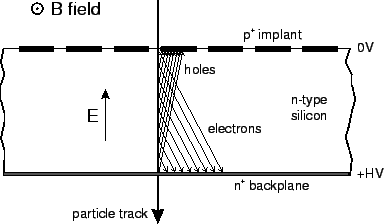Normally, the charge carriers move straight to the electrodes under the
influence of the electric field. If a magnetic field perpendicular to the electric field
is present, as it is the case in the barrel part of the CMS Tracker,
the charges are deflected from their track. A single charge ![]() moving in electric and magnetic
fields
moving in electric and magnetic
fields ![]() and
and ![]() with the velocity
with the velocity ![]() will experience the Lorentz2.5 force
will experience the Lorentz2.5 force ![]() ,
,
| (2.30) |
 |
![[*]](crossref.gif) . Electrons and holes are subjected to different shifts, since
their drift velocities are different. The Hall effect has two consequences:
The electrode target area of the charge widens proportional to the
detector thickness and the target center is offset relative to the particle track.
This ``Lorentz shift'' is usually expressed as an incline angle. With a CMS-like magnetic field
of
. Electrons and holes are subjected to different shifts, since
their drift velocities are different. The Hall effect has two consequences:
The electrode target area of the charge widens proportional to the
detector thickness and the target center is offset relative to the particle track.
This ``Lorentz shift'' is usually expressed as an incline angle. With a CMS-like magnetic field
of
The practical relevance of the Lorentz shift can be minimized by mechanically tilting the detectors
such that the target areas on the electrodes of both electrons and holes coincide. With this
choice, the equal Lorentz shifts of both carriers can be easily corrected by numerical
offset subtraction. In the case of CMS, the corresponding tilt angle is ![]() .
.